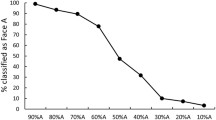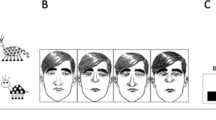Abstract
A diminished top-down influence has been proposed in autism, to account for enhanced performance in low-level perceptual tasks. Applied to perceptual categorization, this hypothesis predicts a diminished influence of category on discrimination. In order to test this hypothesis, we compared categorical perception in 16 individuals with and 16 individuals without high-functioning autism. While participants with and without autism displayed a typical classification curve, there was no facilitation of discrimination near the category boundary in the autism group. The absence of influence of categorical knowledge on discrimination suggests an increased autonomy of low-level perceptual processes in autism, in the form of a reduced top-down influence from categories toward discrimination.



Similar content being viewed by others
Notes
This interpretation has been suggested to us by Michelle Dawson, an autistic researcher
References
Aldrich, J. H., & Nelson, F. D. (1984). Linear probability, logit, and probit models. Beverly Hills: Sage Publications.
Ashby, F. G., Alfonso-Reese, L. A., Turken, A. U., & Waldron, A. M. (1998). A neuropsychological theory of multiple systems in category learning. Psychological Review, 105, 442–481.
Bar, M. (2003). A cortical mechanism for triggering top-down facilitation in visual object recognition. Journal of Cognitive Neuroscience, 15, 600–609.
Bonnel, A. C., Mottron, L., Peretz, I., Trudel, M., Gallun, E., & Bonnel, A. M. (2003). Enhanced pitch sensitivity in individuals with autism: A signal detection analysis. Journal of Cognitive Neuroscience, 15, 226–235.
Bornstein, M. H., & Korda, N. O. (1984). Discrimination and matching within and between hues measured by reaction times: Some implications for categorical perception and levels of information processing. Psychological Research, 46, 207–222.
Bowler, D. M., Matthews, N. J., & Gardiner, J. M. (1997). Asperger’s syndrome and memory: Similarity to autism but not amnesia. Neuropsychologia, 35, 65–70.
Bruner, J. S., Goodnow, J. J., & Austin, G. A. (1956). A study of thinking. Oxford, England: John Wiley & Sons.
Bülthoff, I., & Newell, F. N. (2004). Categorical perception of sex occurs in familiar but not unfamiliar faces. Visual Cognition, 11, 823–855.
Calder, A. J., Young, A. W., Perrett, D. I., Etcoff, N. L., & Rowland, D. (1996). Categorical perception of morphed facial expressions. Visual Cognition, 3, 81–117.
Casanova, M. F., Buxhoeveden, D, & Gomez, J. (2003). Disruption in the inhibitory architecture of the cell minicolumn: implications for autism. Neuroscientist, 9, 496–507.
Cienfuegos, A., March, L., Shelley, A.-M., & Javitt, D. C. (1999). Impaired categorical perception of synthetic speech sounds in schizophrenia. Biological Psychiatry, 45, 82–88.
Collins, A. M., & Quillian, M. R. (1969). Retrieval time from semantic memory. Journal of Verbal Learning & Verbal Behavior, 8, 240–247.
Erickson, M. A., & Kruschke, J. K. (1998). Rules and exemplars in category learning. Journal of Experimental Psychology: General, 127, 107–140.
Etcoff, N. L., & Magee, J. J. (1992). Categorical perception of facial expressions. Cognition, 44, 227–240.
Frith, C. (2003). What do imaging studies tell us about the neural basis of autism? Novartis Foundation Symposium, 251, 149–166.
Frith, U. (2003). Autism: Explaining the enigma. (2nd edition). Malden, MA: Blackwell Publishers.
Frith, U., & Snowling, M. (1983). Reading for meaning and reading for sound in autistic and dyslexic children. Journal of Developmental Psychology, 1, 329–342.
Goldstone, R. L. (1998). Perceptual learning. Annual Review of Psychology, 49, 585–612.
Green, D. M., & Swets, J. A. (1966). Signal detection theory and psychophysics. New York: Wiley.
Grossberg, S. (1999). The link between brain learning, attention, and consciousness. Consciousness and Cognition, 8, 1–44.
Happé, F. (1997). Central coherence and theory of mind: Reading homographs in context. British Journal of Developmental Psychology, 15, 1–12.
Harnad, S. (1987). Categorical perception: The groundwork of cognition. New York: Cambridge University Press.
Harnad, S. (2003). Categorical perception. Encyclopedia of Cognitive Science. Nature Publishing group/Macmillan.
Hermelin, B., & O’Connor, N. (1970). Psychological experiments with autistic children. Oxford: Pergamon Press.
Joliffe, T., & Baron-Cohen, S. (1999). A test of central coherence theory: linguistic processing in high-functioning adults with autism or Asperger’s syndrome: Is local coherence impaired?. Cognition, 71, 149–185.
Just, M. A., Cherkassky, V. L., Keller, T. A., & Minshew, N. J. (2004). Cortical activation and synchronization during sentence comprehension in high-functioning autism: evidence of underconnectivity. Brain, 127, 1811–1821.
Klinger, L. G., & Dawson, G. (2001). Prototype formation in autism. Development and Psychopathology, 13, 111–124.
Koshino, H., Carpenter, P. A., Minshew, N. J., Cherkassky, V. L., Keller, T. A., & Just, M. A. (2005). Functional connectivity in an fMRI working memory task in high-functioning autism. Neuroimage, 24, 810–21.
Kugler, B. T., & Caudrey, D. J. (1983). Phoneme discrimination in schizophrenia. British Journal of Psychiatry, 142, 53–59.
Kuhl, P. K., & Padden, D. M. (1982). Enhanced discriminability at the phonetic boundaries for the voicing feature in macaques. Perception & Psychophysics, 32, 542–550.
Levin, D. T., & Beale, J. M. (2000). Categorical perception occurs in newly learned faces, other-race faces, and inverted faces. Perception and psychophysics, 62, 386–401.
Liberman, A. M. (1996). Speech: A special code. Cambridge, MA: MIT Press.
Liberman, A. M., Harris, K. S., Hoffman, H. S., & Griffith, B. C. (1957). The discrimination of speech sounds within and across phoneme boundaries. Journal of Experimental Psychology, 54, 358–368.
Lopez, B., & Leekam, S. R. (2003). Do children with autism fail to process information in context. Journal of Child Psychology and Psychiatry, 44, 285–300.
Lord, C., Risi, S., Lambrecht, L., Cook, E. H. Jr, Leventhal, B. L., DiLavore, P. C. et al. (2000). The autism diagnostic observation schedule-generic: A standard measure of social and communication deficits associated with the spectrum of autism. Journal of Autism and Developmental Disorders, 30, 205–223.
Lord, C., Rutter, M., & Le Couteur, A. (1994). Autism diagnosis interview-revised: A revised version of a diagnostic interview for caregivers of individuals with possible pervasive developmental disorders. Journal of Autism and Developmental Disorders, 24, 659–685.
Macmillan, N. A., & Creelman, C. D. (1991). Detection theory: A user’s guide. Cambridge: Cambridge University Press.
Medin, D. L., & Schaffer, M. (1978). Context theory of classification learning. Psychological Review, 85, 207–238.
Medin, D. L., & Smith, E. E. (1984). Concepts and concept formation. Annual Review of Psychology, 35, 113–138.
Moleswoth, C. J., Bowler, D. M., & Hampton, J. A. (2005). The prototype effect in recognition memory: Intact in autism? Journal of Child Psychology and Psychiatry, 46, 661–672.
Mottron, L., & Burack, J. A. (2001). Enhanced perceptual functioning in the development of autism. In J. A. Burack, T. Charman, N. Yirmiya, & P. R. Zelazo, (Eds), The development of autism: Perspectives from theory and research. (pp. 131–148). Mahwah, NJ: Lawrence Erlbaum Associates.
Mottron, L., Burack, J. A., Iarocci, G., Belleville, S., & Enns, J. T. (2003). Locally oriented perception and intact global processing among adolescents with high-functioning autism: evidence from multiple paradigms. Journal of Child Psychology and Psychiatry, 44, 1–10.
Mottron, L., Morasse, K., & Belleville, S. (2001). A study of memory functioning in individuals with autism. Journal of Child Psychology and Psychiatry, 42, 253–260.
Newell, F. N., & Bülthoff, H. H. (2002). Categorical perception of familiar objects. Cognition, 85, 113–143.
Nosofsky, R. M., & Johansen, M. K. (2000). Exemplar-based accounts of “multiple-system” phenomena in perceptual categorization. Psychonomic Bulletin & Review, 7, 375–402.
Nosofsky, R. M. (1986). Attention, similarity, and the identification categorization relationship. Journal of Experimental Psychology: General, 115, 39–57.
O’Riordan, M. A., & Plaisted, K. (2001). Enhanced discrimination in autism. The Quarterly Journal of experimental psychology, 54A, 961–979.
Pevtzow, R., & Harnad, S. (1997). Warping similarity space in category learning by human subjects: The role of task difficulty. In M. Ramscar, U. Hahn, E. Cambouropolos, & H. Pain (Eds), Proceedings of SimCat 1997: Interdisciplinary Workshop on Similarity and Categorization. (pp. 189–195). Department of Artificial Intelligence, Edinburgh University.
Plaisted, K. (2001). Reduced generalization: An alternative to weak central coherence. In J. A. Burack, T. Charman, N. Yirmiya, & P. R. Zelazo, (Eds), The development of autism: Perspectives from theory and research. (pp. 149–169). Mahwah, NJ: Lawrence Erlbaum Associates.
Plaisted, K., O’Riordan, M., & Baron-Cohen, S. (1998). Enhanced discrimination of novel, highly similar stimuli by adults with autism during a perceptual learning task. Journal of Child Psychology and Psychiatry, 39, 765–775.
Quinn, P. (2004). Visual perception of orientation is categorical near vertical and continuous near horizontal. Perception, 33, 897–906.
Ropar, D., & Mitchell, P. (2002). Shape constancy in autism: The role of prior knowledge and perspective cues. Journal of Child Psychology and Psychiatry, 43(5), 647–653.
Rosch, E. (1975a). Cognitive representations of semantic categories. Journal of Experimental Psychology: General, 104, 192–233.
Rosch, E. (1975b). Cognitive reference points. Cognitive Psychology, 7, 532–547.
Rosch, E., & Mervis, C. B. (1975). Family resemblances: Studies in the internal structure of categories. Cognitive Psychology, 7, 573–605.
Rossion, B., Schiltz, C., Robaye, L., Pirenne, D., & Crommelinck, M. (2001). How does the brain discriminate familiar and unfamiliar faces?: A PET Study of face categorical perception. Journal of Cognitive Neuroscience, 13, 1019–1034.
Saumier, D., Chertkow, H., Arguin, M., & Renfrew, J. (in revision). Perceptual categorization in Alzheimer’s disease.
Saumier, D., Chertkow, H., Arguin, M., & Whatmough, C. (2005). Establishing visual category boundaries between objects: A PET study. Brain & Cognition, 59, 299–302.
Serniclaes, W., Sprenger-Charolles, L., Carre, R., & Demonet, J. F. (2001). Perceptual discrimination of speech sounds in developmental dyslexia. Journal of Speech, Language, & Hearing Research, 44, 384–399.
Tager-Flusberg, H. (1991). Semantic processing in the free recall of autistic children: Further evidence for a cognitive deficit. British Journal of Developmental Psychology, 9, 417–430.
Teunisse, J. P., & de Gelder, B. (2001). Impaired categorical perception of facial expressions in high-functioning adolescents with autism. Child Neuropsychology, 7, 1–14.
Acknowledgments
This project was funded by a scholarship from NSERC and FCAR (I.S.), a Chercheur Boursier from FRSQ and a grant from CIHR (L.M.). We thank Lisa-Marie Sauvé and Geneviève Martel for assistance, Claude Berthiaume for help with statistical analyses, Michelle Dawson for helpful comments, and Martin Arguin for providing the stimuli. We also thank the participants and their families. This study was presented as part of Ph.D. dissertation of the first author.
Author information
Authors and Affiliations
Corresponding author
Rights and permissions
About this article
Cite this article
Soulières, I., Mottron, L., Saumier, D. et al. Atypical Categorical Perception in Autism: Autonomy of Discrimination?. J Autism Dev Disord 37, 481–490 (2007). https://doi.org/10.1007/s10803-006-0172-4
Published:
Issue Date:
DOI: https://doi.org/10.1007/s10803-006-0172-4




